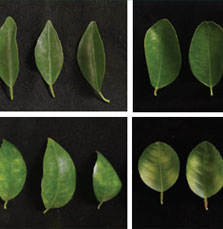การเปลี่ยนแปลงทางกายวิภาคของเส้นกลางใบในพืชสกุลส้มที่ได้รับผลกระทบจาก โรคฮวงลองบิงด้วยเทคนิคการย้อมสี
คำสำคัญ:
โรคฮวงลองบิง, เอชแอลบี, เส้นกลางใบ, พืชสกุลส้ม, เทคนิคการย้อมสีบทคัดย่อ
โรคฮวงลองบิงหรือกรีนนิ่งในพืชสกุลส้ม เป็นโรคที่สร้างความเสียหายรุนแรงแก่พืชสกุลส้มทั่วโลก โดยมีเชื้อสาเหตุ คือ Candidatus Liberibacter asiaticus (Las) ซึ่งเป็นแบคทีเรียที่อาศัยอยู่ในท่ออาหาร ความเสียหายที่เกิดจากโรคฮวงลองบิงทำให้ผลผลิตของพืชลดลง และใบด่าง ซึ่งเป็นผลที่เกิดจากความเสียหายในส่วนของท่ออาหาร พืชสกุลส้มที่ศึกษาในครั้งนี้ คือ ส้มเขียวหวาน มะนาว และส้มโอ โดยได้ผ่านการตรวจยืนยันเชื้อสาเหตุโรคฮวงลองบิงด้วยวิธีการ PCR ซึ่งพบเชื้อสาเหตุโรค 13 ตัวอย่างจากทั้งหมด 28 ตัวอย่าง จากนั้นนำมาศึกษาโครงสร้างบริเวณท่อลำเลียง และเนื้อเยื่อโดยรอบของพืชปกติ และพืชที่มีการเข้าทำลายของเชื้อสาเหตุโรคฮวงลองบิง ภายใต้กล้องจุลทรรศน์ compound microscope ซึ่งตัดเนื้อเยื่อด้วยเครื่อง freezing microtome และย้อมสีเนื้อเยื่อด้วย 0.1% Toluidine blue เพื่อให้เห็นความแตกต่างของเนื้อเยื่อชัดเจนมากยิ่งขึ้น และ 3% Iodine เพื่อดูการสะสมแป้งในโครงสร้างของเส้นกลางใบ ซึ่งผลได้แสดงให้เห็นว่าเชื้อสาเหตุมีผลต่อระบบเนื้อเยื่อท่อลำเลียง ในส่วนของ phloem fiber มีความผิดปกติไม่เรียงตัวรอบท่ออาหาร เซลล์ท่ออาหารมีการขยายตัวที่ผิดปกติ ทำให้ท่ออาหารมีความหนามากขึ้น และพบการสะสมแป้งที่เพิ่มขึ้นมากกว่าปกติอย่างชัดเจน
เอกสารอ้างอิง
สำนักงานเศรษฐกิจการเกษตร. 2562. ตารางแสดงรายละเอียดส้มเขียวหวาน. (ระบบออนไลน์). แหล่งข้อมูล: https://
www.oae.go.th/view/1/ตารางแสดงรายละเอียดส้มเขียวหวาน/TH-TH (10 ตุลาคม 2563).
Akarapisan, A., W. Kuenpech, and K. Srimai. 2016. Huanglongbing (HLB) incidence on 2-3 years old tangerine
trees (Citrus reticulata) grown from disease-free nursery stock. Journal of Agricultural Technology 12(1): 1-9.
Albrigo, L.G., L.L. Stelinski and W.L. Timmer. 2019. Citrus (2). Boston, MA: CABI, USA, 324 p.
Bove, J. M. 2006. Huanglongbing: A destructive, newly-emerging, century-old disease of citrus. Journal of
Plant Pathology 88(1): 7-37.
Calissendorff, J. and H. Falhammar. 2017. Lugol’s solution and other iodide preparations: perspectives and
research directions in Graves’ disease. Endocrine 58: 467–473.
Da Graça, J.V. 1991. Citrus greening disease. Annual Review of Phytopathology 29:109-136.
Dellaporta, S.L., J. Wood and J.B. Hicks. 1983. A plant DNA minipreparation: Version II. Plant Molecular
Biology Reporter 1(4): 19-21.
Deng, H., D. Achor, E. Exteberria, Q. Yu, D. Du, D. Stanton, G. Liang and F.G. Gmitter,Jr. 2019. Phloem
regeneration is a mechanism for Huanglongbing-tolerance of “Bearss” lemon and “LB8-9” Sugar
Belle® mandarin. Frontiers in Plant Science 10(277): 1-13.
Etxeberria, E. and C. Narciso. 2012. Phloem anatomy of citrus trees: Healthy vs. greening-affected.
Proceedings of the Florida State Horticultural Society 125: 67-70.
Fujikawa, T. and T. Iwanami. 2012. Sensitive and robust detection of citrus greening (huanglongbing)
bacterium “Candidatus Liberibacter asiaticus” by DNA amplification with new 16S rDNA specific
primers. Molecular and Cellular Probes 26: 194-197.
Hao, G., D. Ammar, Y. Duan and E. Stover. 2019. Transgenic citrus plants expressing a ‘Candidatus Liberibacter
asiaticus’ prophage protein LasP235 display Huanglongbing-like symptoms. Agri Gene 12 (100085): 1-10.
Parker, A.J., E.F. Haskins and I. Deyrup-Olsen. 1982 . Toluidine blue: A simple, effective stain for plant
tissues. The American Biology Teacher 44(8): 487–489.
Parker, M.L., P. Ryden, P.J. Wilde and C.H. Edwards. 2021. A simple and effective method for observing
starch in whole plant cells and in raw and processed food ingredients. Starch – Stärke 73: 2000056.
Ploetz, R. 2003. Diseases of Mango,pp. 327-363. In: R.C. Ploetz (ed.) Diseases of Tropical Fruit Crops. CABI Publishing.
Wallingford, UK.
Sechler, A., E.L. Schuenzel, P. Cooke, S. Donnua, N. Thaveechai, E. Postnikova, A.L. Stone, W.L. Schneider, V. D.
Damsteegt, and N.W. Schaad. 2009. Cultivation of ‘Candidatus Liberibacter asiaticus’, ‘Ca. L. africanus’,
and ‘Ca. L. americanus’ associated with Huanglongbing. Phytopathology 99:480-486.
Smith, A. 2021. What happens when the leaf is dipped in iodine solution?. (Online): Available Source: https:// rehabilitationrobotics.net/what-happens-when-the-leaf-is-dipped-in-iodine-solution/#What_
happens_when_the_leaf_is_dipped_in_iodine_solution, (June 17, 2021).
Zhou, J. 2017. Histochemistry. Xi'an Jiaotong University Press Co., China, 242 p.






